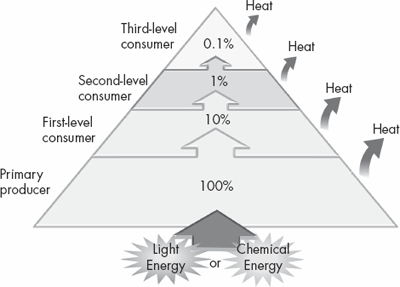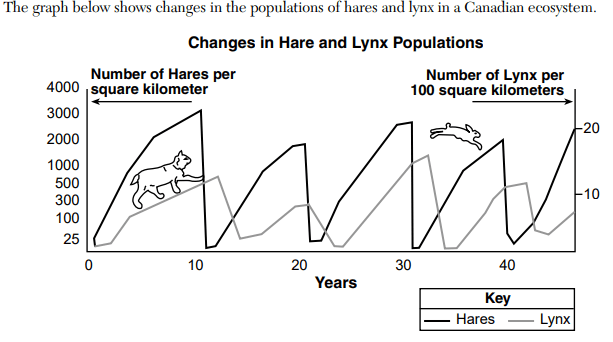4. The first organism in most natural food chains is
1) an herbivore
2) a decomposer
3) photosynthetic
4) carnivorous
3. Photosynthetic
A symbiotic relationship exists between two organisms of different species. If only one organism benefits from the relationship and the other is not harmed, the relationship is known as
1. Mutualism
2. Commensalism
3. Saprophytism
4. Paratisism
2. Commensalism
Mother rattlesnakes care for and protect their young. Baby rattlesnakes find safety in the coils of their mothers. Femlae snakes stay together for the first few weeks after giving irth. This gathering of female rattlesnakes provides a safe environment for newborn rattlers. This is an examples of which type of adaptation?
A. Structural
B. Nutritional
C. Molecular
D. Behaviorial
D. Behaviorial
What are the two types of ecological succession?
- primary and secondary
- abiotic and biotic
- plant and animal
- erosion and deposition
1. primary and secondary
All the abiotic and biotic factors in an area are
1. species
2. population
3. ecosystem
4. community
3. ecosystem
Decomposers are necessary in a food chain because they
A. Manufacture food by photosynthesis
B. Return nutrients to the ecosystem
C. Absorb energy from the Sun
D. Produce organic materials
B. Return nutrients to the ecosystem
6. In 1960, an invasive species of fish was introduced into the stable ecosystem of a river. Since then, the population of a native fish species has declined. This situation is an example of an
1) ecosystem that has recovered
2) ecosystem altered through the activities of an organism
3) environmental impact caused by physical factors
4) ecological niche without competition
2) ecosystem altered through the activities of an organism
The process by which one community is replaced by another; bedrock - lichens - mosses- grasses - trees and shrubs - forest
A. Ecological succession
B. Habitats
C. Energy Pyramid
D. Ecological Niche
A. Ecological succession
 Identify the ecological process that is represented from stage A through stage D, and explain why each stage is important to the stage that follows it.
Identify the ecological process that is represented from stage A through stage D, and explain why each stage is important to the stage that follows it.
Primary Succession
— Each stage modifies the environment for the next stage.
Carbon dioxide and oxygen are important resources in the ecosystems and are
A. recycled through the activity of living and nonliving systems
B. Stored in the animals of the ecosystem
C. Lost due to the activities of decomposes
D. Released by the process of photosynthesis
A. recycled through the activity of living and nonliving systems
7. A food web is represented below
When water used to cool machinery is returned to a river, it raises the river water temperature.
This causes a sharp decline in small invertebrate populations. Based on the food web, a likely consequence of this change would be
1) an increase in the number of clams
2) a decrease in the number of water plants
3) an increase in the number of crabs
4) a decrease in the number of crayfish
4) a decrease in the number of crayfish
Dodder Plants consist of tangles masses of yellow leafless vines and contain few chloroplasts. The vines twist around and grow into the stems of other plants and absorb water and nutrients from them. Which statement best describes this relationship?
1. Dodder plants are parasitism, relying on host organisms for resources
2. Dodder plants are decomposers, returning organic material back into the environment.
3. Dodder plants are producers, while the other plants that they attach to are consumers.
4. Dodder plants are consumers, transferring energy to other plants in the ecosystem.
1. Dodder plants are parasitism, relying on host organisms for resources
32. The phrase “carrying capacity” refers to
(1) storing extra food for the winter
(2) the number of organisms a habitat can support
(3) transporting food to organisms in an area
(4) the maximum possible weight of an individual organism
(2) the number of organisms a habitat can support
The first organisms to repopulate an area affected by a volcanic eruption are
- pioneer species.
- primary producers.
- climax species.
- keystone species.
1. pioneer species.
In a food pyramid, energy is lost as heat to the environment due to organisms _____________________
Metabolic Processes
 Describe why energy is lost traveling up the pyramid. What process are taking place at each level?
Describe why energy is lost traveling up the pyramid. What process are taking place at each level?
BONUS: What is a Producer?
Energy is lost through metabolic processes
Producers are organisms that make their own food
Ex. Plants
Sea anemones are mainly sessile animals. Some of them depend on the motile clown fish for their survival. The clown fish helps to provide food for the sea anemone as it seeks protection in the anemone's tentacles. This symbiotic relationship is known as
commensalism
saprophytism
mutualism
parasitism
3. mutualism
Another name for heterotroph; An organism that obtains its energy from producers.
A. Scavenger
B. Consumer
C. Parasite
D. Decomposer
B. Consumer
During ecological succession, when are pioneer species found?
- during the early stages
- during the late stages
- at the very end
- never
- during the early stages
Identify two abiotic factors that can determine which types of organisms can inhabit an ecosystem
— light intensity and temperature
— soil composition and pH
— water availability and light
10. Which statement best describes some organisms in the food web shown below?
1. Minnows and fish are primary consumers.
2. Algae and floating plants are decomposers.
3. Aquatic crustaceans are omnivores.
4. Raccoons, fish, and ducks are secondary consumers.
4. Raccoons, fish, and ducks are secondary consumers.
 Which statement about the hares and lynx can be supported with information from the graph?
Which statement about the hares and lynx can be supported with information from the graph?
(1) The hare is the predator of the lynx because it is a larger animal.
(2) The lynx population begins to drop after the hare population drops.
(3) Both populations go through cycles due to the succession of plant species.
(4) Both populations have a carrying capacity of 3000 per square kilometer.
(2) The lynx population begins to drop after the hare population drops.
A representation of interconnected food chains that show more complex feeding relationships between producers, consumers, and decomposers.
Food Web
Which of the following is an example of primary succession?
1. A plant community becoming simplified with fewer species and less biomass
2. Plant communities are established in a lifeless environment, usually devoid of soil
3. A succession of larger plants (trees, shrubs, etc.) following the establishment of pioneer species
4. A transition from one ecosystem type to another
2. Plant communities are established in a lifeless environment, usually devoid of soil
Euglena are unique single-celled organisms. Depending on the physical conditions present in their aquatic environments, Euglena can act as either producers or consumers.
Euglena will most likely act as consumers when placed in an environment that has
1. an acidic pH
2. a low oxygen level
3. little to no light present
4. many predators
3. little to no light present